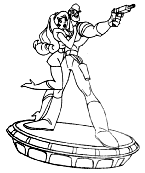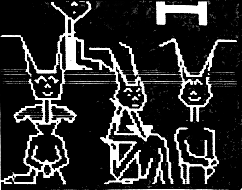A comment by Ken Clark

Computer games are limited in their ability to produce a graphic display by the K-factor. 16K cannot be expected to generate complicated pictures in full colour. Yet, the public is being coaxed into buying and using home computers by means of a plethora of games. While this is an excellent fun method of induced learning, there are already signs that we are reaching saturation point. That well advertised firm Atari floundered recently and had to re¬think its strategy.
It is not because the consumer is tiring of games, rather that he is tiring of the form or presentation. Consider the new alternative. In America, the laser disc is offering more sophisticated, fully animated games with built-in freedom of choice to select from a variety of options The picture on-screen resembles a Disney type feature cartoon – a world of pure fantasy wherein lurk monstrous shapes. The player interacts with the visuals, making mistakes in play and placing him or herself in great danger and then influencing the subsequent outcome of the mythical adventure. It is the fully animated characterisations and backgrounds that make this type of game a far cry from the simple Pac Man character and its limited array of blips and plops. Blips and plops are no match for a fully orchestrated score. Atari are aware of the challenge of the laser-disc, for they are now marketing their own.

Producers of animated films photograph a sequence of drawings, each drawing advancing the movements a little at a time. Computer games programmers employ a similar technique to effect movement, although their generated characters are designed and moved by machine code. Computer pictures although acceptable, lack realism, they appear unsophisticated because their jerky movements do not follow the basic rules of animated film movement. In the case of simple games with limited computing power this has been of little consequence.
However, the industry does not stand still. Storage capacities are increasing and the graphics are improving. Admittedly, not to the extent that they can compete on equal terms with vision and sound lifted from a disc by a laser beam, but in time more satisfying presentations will be produced by computer. Improvement relies upon greater- K-power, better colour graphics and realistic sound – all at lower cost.
Meanwhile, it is in the interests of games producers to consult the film animator if he wishes to improve the quality of his product. Animators and computer programmers should get together; the two disciplines must be fully understood before the one can benefit from the other.
Printed in Animator’s newsletter Issue 9 (Summer 1984)
